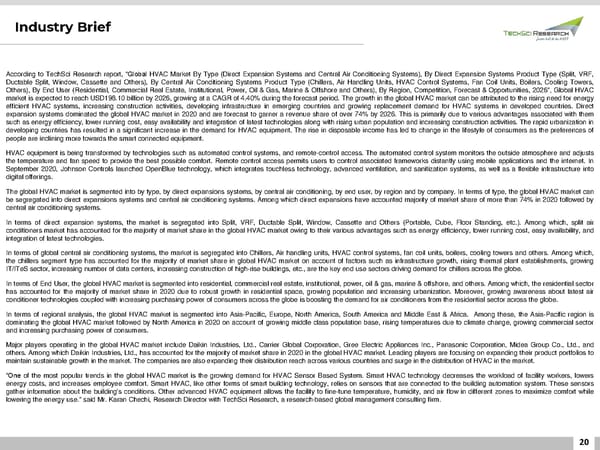Industry Brief According to TechSci Research report, “Global HVAC Market By Type (Direct Expansion Systems and Central Air Conditioning Systems), By Direct Expansion Systems Product Type (Split, VRF, Ductable Split, Window, Cassette and Others), By Central Air Conditioning Systems Product Type (Chillers, Air Handling Units, HVAC Control Systems, Fan Coil Units, Boilers, Cooling Towers, Others), By End User (Residential, Commercial Real Estate, Institutional, Power, Oil & Gas, Marine & Offshore and Others), By Region, Competition, Forecast & Opportunities, 2026”, Global HVAC market is expected to reach USD198.10 billion by 2026, growing at a CAGR of 4.40% during the forecast period. The growth in the global HVAC market can be attributed to the rising need for energy efficient HVAC systems, increasing construction activities, developing infrastructure in emerging countries and growing replacement demand for HVAC systems in developed countries. Direct expansion systems dominated the global HVAC market in 2020 and are forecast to garner a revenue share of over 74% by 2026. This is primarily due to various advantages associated with them such as energy efficiency, lower running cost, easy availability and integration of latest technologies along with rising urban population and increasing construction activities. The rapid urbanization in developing countries has resulted in a significant increase in the demand for HVAC equipment. The rise in disposable income has led to change in the lifestyle of consumers as the preferences of people are inclining more towards the smart connected equipment. HVACequipment is being transformed by technologies such as automated control systems, and remote-control access. The automated control system monitors the outside atmosphere and adjusts the temperature and fan speed to provide the best possible comfort. Remote control access permits users to control associated frameworks distantly using mobile applications and the internet. In September 2020, Johnson Controls launched OpenBlue technology, which integrates touchless technology, advanced ventilation, and sanitization systems, as well as a flexible infrastructure into digital offerings. The global HVAC market is segmented into by type, by direct expansions systems, by central air conditioning, by end user, by region and by company. In terms of type, the global HVAC market can be segregated into direct expansions systems and central air conditioning systems. Among which direct expansions have accounted majority of market share of more than 74% in 2020 followed by central air conditioning systems. In terms of direct expansion systems, the market is segregated into Split, VRF, Ductable Split, Window, Cassette and Others (Portable, Cube, Floor Standing, etc.). Among which, split air conditioners market has accounted for the majority of market share in the global HVAC market owing to their various advantages such as energy efficiency, lower running cost, easy availability, and integration of latest technologies. In terms of global central air conditioning systems, the market is segregated into Chillers, Air handling units, HVAC control systems, fan coil units, boilers, cooling towers and others. Among which, the chillers segment type has accounted for the majority of market share in global HVAC market on account of factors such as infrastructure growth, rising thermal plant establishments, growing IT/ITeS sector, increasing number of data centers, increasing construction of high-rise buildings, etc., are the key end use sectors driving demand for chillers across the globe. In terms of End User, the global HVAC market is segmented into residential, commercial real estate, institutional, power, oil & gas, marine & offshore, and others. Among which, the residential sector has accounted for the majority of market share in 2020 due to robust growth in residential space, growing population and increasing urbanization. Moreover, growing awareness about latest air conditioner technologies coupled with increasing purchasing power of consumers across the globe is boosting the demand for air conditioners from the residential sector across the globe. In terms of regional analysis, the global HVAC market is segmented into Asia-Pacific, Europe, North America, South America and Middle East & Africa. Among these, the Asia-Pacific region is dominating the global HVAC market followed by North America in 2020 on account of growing middle class population base, rising temperatures due to climate change, growing commercial sector and increasing purchasing power of consumers. Major players operating in the global HVAC market include Daikin Industries, Ltd., Carrier Global Corporation, Gree Electric Appliances Inc., Panasonic Corporation, Midea Group Co., Ltd., and others. Among which Daikin Industries, Ltd., has accounted for the majority of market share in 2020 in the global HVAC market. Leading players are focusing on expanding their product portfolios to maintain sustainable growth in the market. The companies are also expanding their distribution reach across various countries and surge in the distribution of HVAC in the market. “One of the most popular trends in the global HVAC market is the growing demand for HVAC Sensor Based System. Smart HVAC technology decreases the workload of facility workers, lowers energy costs, and increases employee comfort. Smart HVAC, like other forms of smart building technology, relies on sensors that are connected to the building automation system. These sensors gather information about the building's conditions. Other advanced HVAC equipment allows the facility to fine-tune temperature, humidity, and air flow in different zones to maximize comfort while lowering the energy use.” said Mr. Karan Chechi, Research Director with TechSci Research, a research-based global management consulting firm. 20
 GLOBAL HVAC MARKET TREND 2026 Page 19 Page 21
GLOBAL HVAC MARKET TREND 2026 Page 19 Page 21